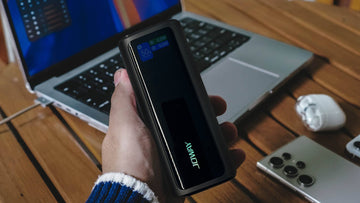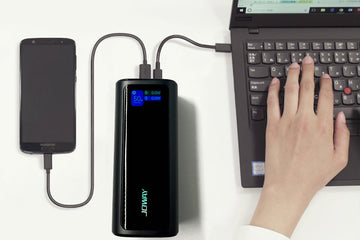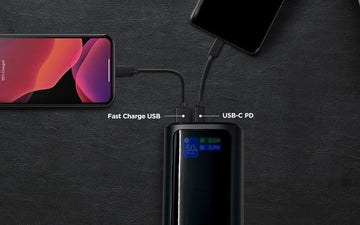
Power Bank vs. Portable Charger: Understanding the Key Differences
by leekelly on Aug 26, 2023
Introduction
In today's fast-paced world, staying connected is crucial. Whether you're traveling, working, or simply on the go, having a reliable power source for your devices is essential. When it comes to mobile charging solutions, two terms are often used interchangeably: power bank and portable charger. However, these two are not exactly the same. Understanding their differences can help you make an informed purchasing decision.
This article will delve into the distinctions between a power bank and a portable charger, highlighting their functionalities, use cases, and how to choose the right one for your needs.
What Is a Power Bank?
A power bank is an external battery pack designed to store electrical energy and later use it to charge other devices. It typically features one or more USB output ports, allowing you to connect smartphones, tablets, laptops, and even small appliances. Power banks come in various capacities, ranging from 5,000mAh to over 50,000mAh, making them ideal for extended power backup needs.
Features of a Power Bank
-
Rechargeable Battery – Stores energy for later use.
-
Multiple Ports – Allows charging of multiple devices simultaneously.
-
High Capacity Options – Suitable for extended trips or emergencies.
-
Wireless Charging Capability – Some models include Qi wireless charging features.
-
Fast Charging Technology – Supports Quick Charge (QC) and Power Delivery (PD).
-
LCD Display or LED Indicators – Shows battery status and power levels.
Common Uses of a Power Bank
-
Charging smartphones and tablets during long trips.
-
Providing backup power for cameras, gaming devices, and smartwatches.
-
Keeping essential devices powered during power outages or emergencies.
-
Supporting outdoor activities like camping and hiking.
What Is a Portable Charger?
A portable charger is a broader term that refers to any device designed to recharge electronic gadgets while on the move. This category includes power banks, but it also encompasses plug-in wall chargers, car chargers, and solar chargers.
Unlike power banks, portable chargers do not always have built-in batteries. For example, a wall charger is considered a portable charger, but it requires a direct power source to function.
Features of a Portable Charger
-
Different Power Sources – Can be battery-operated, wall-powered, or solar-powered.
-
Compact and Lightweight – Often smaller than traditional power banks.
-
Single or Multiple Outputs – Available in single-port or multi-port designs.
-
High-Speed Charging – Some models support fast-charging technologies.
-
Car and Solar Variants – Includes car chargers and solar-powered options.
Common Uses of a Portable Charger
-
Charging devices when an electrical outlet is available.
-
Providing power through a car's 12V socket.
-
Using solar energy to charge devices in remote areas.
-
Powering devices with minimal need for stored battery energy.
Key Differences Between a Power Bank and a Portable Charger
| Feature | Power Bank | Portable Charger |
|---|---|---|
| Power Source | Built-in battery | Direct power or built-in battery |
| Charging Capability | Can charge multiple devices on the go | Needs a power source unless battery-operated |
| Portability | Compact but can be bulky for high-capacity models | Generally more compact and lightweight |
| Capacity Range | 5,000mAh to 50,000mAh+ | Varies (some have no battery storage) |
| Charging Speed | Supports fast charging (PD, QC) | Depends on the model (wall, car, or solar) |
| Use Case | Best for power backup and travel | Best for immediate charging near power sources |
Which One Should You Choose?
When deciding between a power bank and a portable charger, consider the following factors:
1. Usage Needs
-
If you need power on the go without access to a power outlet, a power bank is the better choice.
-
If you frequently charge devices near power sources, a portable charger (like a wall charger or car charger) may be more convenient.
2. Device Compatibility
-
Power banks are versatile and work with various devices, including smartphones, tablets, and laptops.
-
Portable chargers vary by type; a wall charger works best for indoor use, while a car charger is ideal for travel.
3. Capacity Requirements
-
If you need multiple charges for your devices, opt for a high-capacity power bank (10,000mAh+).
-
If you just need a quick charge, a plug-in portable charger might be sufficient.
4. Portability
-
Power banks are bulkier but offer greater flexibility.
-
Portable chargers (like wall and car chargers) are lighter and easier to carry but require a power source.
Conclusion
While power banks and portable chargers serve the same ultimate purpose—keeping your devices charged—their functionalities differ significantly. Power banks store energy and offer portable power anytime, anywhere, while portable chargers (including wall, car, and solar chargers) are designed to charge devices when connected to a power source.
When choosing between the two, consider your power needs, travel habits, and device requirements. Whether you're looking for a high-capacity backup battery or a compact wall charger, selecting the right charging solution ensures that your devices remain powered whenever you need them most.




